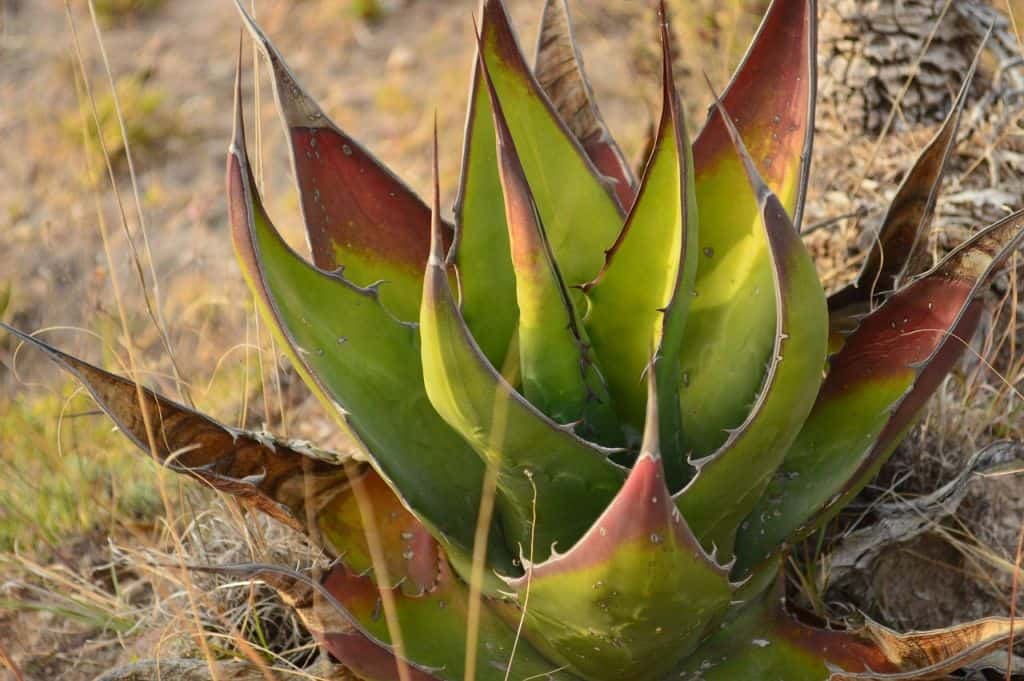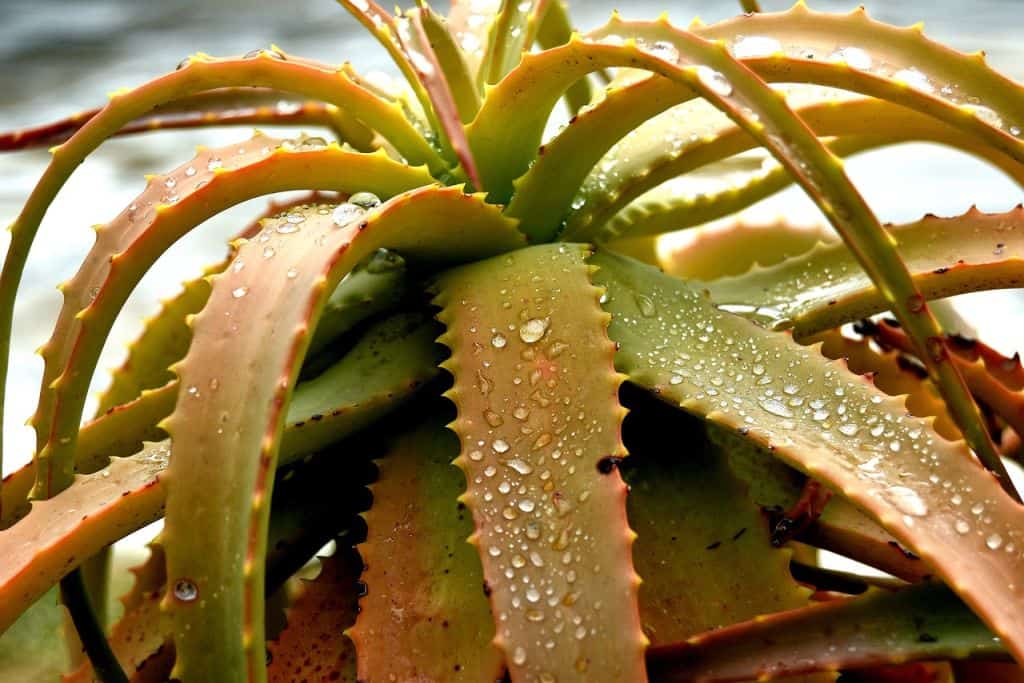When the aloe turns brown it is a sign that something is wrong with it. Owners of this great plant have been asking themselves for years why their aloe turns brown.
The best answer to why aloe vera turns brown is simply too much water, which causes the aloe vera leaves to rot. The solution is to reduce the amount of water or the frequency of watering.
Of course, it is quite easy to say it, but you have to be sure that the case we are dealing with is “water overdose” ?
After all, excess water does not have to be the cause of browning aloe leaves.
So I invite you to read my post about brown aloe leaves.
Aloe turns brown
As a rule, the process of browning aloe vera leaves begins quite innocently and imperceptibly. Aloe leaves gradually turn brown from the outer edge of the leaves towards the stalk. With time, you can also notice a change in colour of the younger leaves that come out of the aloe vera stem to brown.
Aloe is a succulent that does not require special treatment, but it must be taken care of.
Aloe is getting brown from too much water
As I wrote before, excess water is the most common reason why aloe leaves turn brown. In my experience, we usually think that we water succulents rather sparingly and the reality is completely different.
Aloe, like Echeveria and other succulents, does not require large amounts of water.
In summer, if you don’t put it outside, it is enough to water the aloe vera once a week or two. It depends on the ambient temperature, but the best method is to check the soil moisture level in the pot.
Each time before watering, touch the ground with your finger and check if it is moist. If so, there is no need to water your aloe vera. If the soil seems dry and aerated, it is a sign that watering is possible.
If you are growing aloe vera on a ready-made soil-succulent mixture, you can feel at this point that the soil is slightly bending. The ready-made soil mixtures have such a composition that they are quite permeable and when dry they seem to be inflated.
Aloe brown leaves due to chemicals, salt, and fertilizers
Browning of aloe vera is not always caused by too much water, however.
Another reason why aloe leaves turn brown may be due to excess salt in the soil. Some fertilizers cause a large amount of salt to build up in the ground, damaging the structure of the aloe vera leaves.
In such a situation, it is best to transplant the plant into a new pot and replace the entire soil with a new one. I read that you can rinse such soil with water, but I have never used it myself. It seems to me that it is much easier to just replace it with a new one.
If you put your aloe vera outdoors in the summer, be sure to pay attention to its surroundings. Some chemicals that are blown in the wind can also cause aloe vera to turn brown.
The extreme case here are herbicides, the use of which may be unlikely … although … my neighbour loves to spray all his plants at the fence with various substances. Even the smallest insect bothers him because it disturbs his vision of the world and such wind-borne substances can also damage your aloe vera.
But let’s go on.
Aloe is turning brown due to the temperature difference
Most varieties of aloe prefer warm climates. The temperature between 13 and 27 degrees Celsius is the best for aloe, which is why it feels so great in apartments and houses.
if you grow aloe vera at home, pay attention to the tightness of the window, if the pot is on the windowsill. You can just blow through a leaky window.
If a plant grows in a clay pot and is exposed to such leaks, the roots may be much colder than the temperature inside the room.
You can easily check it by touching the pot from the window side and moving your hand to the other side of the pot. If you sense a temperature difference, simply move the aloe farther away from this window or find another place for it.
There is another situation where aloe vera may be exposed to temperature differences. If you put it outside, check the temperature there in the evenings.
It may turn out that the temperature at night drops below 13 degrees Celsius, and then it is too cold for the aloe vera.
Aloe turns brown from the sun

This is the greatest irony about aloe vera. We can read in every textbook that aloe loves bright, warm places.
Unfortunately, we do not always remember that bright does not mean direct sun. Most of the plants that grow in our climate do well in direct sunlight, but not aloe vera.
Too much direct sunlight can cause the leaves of the aloe vera to turn brown, sometimes as dark spots.
Most often, leaf burns occur when the plant is placed outside, trying to make it bloom. Aloe needs a bit of direct sunlight to bloom, but this is easy to overdo. It is not known how long you can expose it to the sun, but my experience shows that two hours in direct sunlight do not hurt it.
I put my aloe vera on the terrace in the summer, in such a place that in about two hours there will be shade there. It is the easiest way.
What else causes aloe vera browning?
Aloe has brown leaf tips
The brown tips of aloe vera leaves are most often a signal of too much water. The leaf rot process begins at the edge of the leaves and gradually progresses towards the stalk.
Healthy Aloe Vera leaves are juicy and fleshy, filled with a gel that is often used for burns and minor scratches. Like all succulents, it needs a small amount of water, so be sure to pay attention to watering.
If you want to know more about it, check out my post on how to water succulents.
Another reason for the appearance of brown leaf tips may be sunburn, which I wrote about earlier. The leaves look like their tips are dry
Aloe – brown leaves from diseases
Several aloe vera diseases manifest as brown leaves. They can destroy this wonderful plant, so it is necessary to fight them.
The problem with aloe vera diseases is that they are not well described, i.e. it is not entirely clear what we are fighting with.
As far as I know, aloe vera can attack:
- aloe anthracnose as manifested by dark sunken leaf lesions
- Aloe leaf spot caused by the fungus Curvularia
- leaf disease caused by Alternaria
These are certainly not all aloe vera diseases that turn brown, but these appear to be the most common.
The only way to combat them is to reduce irrigation and use chemicals. I have to admit, I don’t like chemistry with plants, but sometimes there’s no way out.
You can also try mushrooms that feed on other mushrooms ? I
used this biological solution a few years ago with my tomatoes, which caught the plague every year. The agent that I used is called Polyversum. This is produced by Target and can be purchased from in most of the garden shops.
Aloe has brown spots due to dust mites
Sometimes you can see brown spots on aloe vera leaves due to mites. These microscopic creatures slowly eat aloe vera, and unfortunately, it may be too late before we understand this.
The mites are too small for us to see, but their activity leaves traces of various kinds. When attacked by mites, aloe leaves not only have brown spots but also develop in unusual ways.
They look like they have been infected, they twist along the leaf and grow deformed. The reason for this is a chemical that gets into the plant with every bite. In this situation, we have no choice but to use chemicals if we want to save the aloe.
So much for the answer to why aloe turns brown. As you can see, there are many reasons why aloe leaves turn brown and it’s not just too much water. So let’s take a closer look at the problem to find a suitable solution.
I also invite you to my guide on caring for aloe vera, in which I show you how to care for this wonderful plant.
As always, please share this post if it is helpful for you. Friends may also find some information on brown aloe leaves or how to care for succulents.
Bye 🙂

